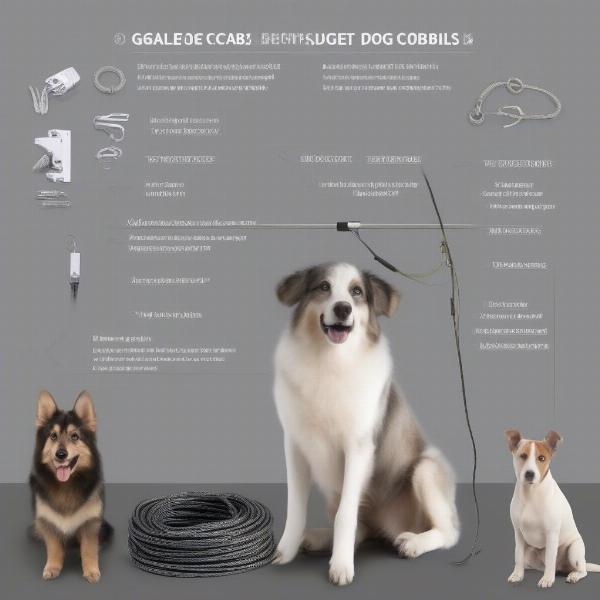Dog cables, also known as tie-out cables or trolley systems, offer a way to give your dog some outdoor freedom while maintaining a safe and controlled environment. They are a popular choice for pet owners who may not have a fenced yard or need a temporary containment solution while camping or traveling. Choosing the right dog cable and using it responsibly is crucial for your dog’s well-being and safety. This article will guide you through everything you need to know about dog cables, from choosing the right type to ensuring your dog’s safety and comfort.
Choosing the Right Dog Cable
Selecting the appropriate dog cable depends on several factors, including your dog’s size, breed, temperament, and the environment where the cable will be used. For larger, stronger breeds, a heavy-duty cable made from durable materials like coated steel is recommended. Smaller dogs might be fine with a lighter cable made from nylon or other synthetic materials.
 Choosing the Right Dog Cable for Your Dog
Choosing the Right Dog Cable for Your Dog
Consider the length carefully. A longer cable provides more freedom, but it also increases the risk of entanglement. Ensure the cable is long enough for your dog to comfortably explore but not so long that it reaches dangerous areas like roads or your neighbor’s property. Also, consider the environment. If you’ll be using the cable in a wooded area, opt for a cable that is less likely to get tangled in trees and bushes.
Ensuring Your Dog’s Safety with a Cable
While dog cables offer convenience, responsible usage is essential to prevent accidents and injuries. Never leave your dog unattended on a tie-out for extended periods. Regularly inspect the cable for any signs of wear and tear, such as fraying or rust. Replace the cable immediately if you notice any damage.
Always attach the cable to a secure anchor point that can withstand your dog’s strength. Avoid attaching it to flimsy objects that could easily break or be pulled over. A dog leash anchor can be a great solution for this. Use a properly fitted harness rather than a collar to prevent choking or neck injuries, especially with strong pullers. When using a strong dog lead ensure it’s compatible with the cable and your dog’s size.
Providing Enrichment and Comfort
Being tethered can be boring for a dog, so it’s essential to provide enrichment and ensure their comfort. Offer chew toys, interactive puzzles, and other forms of entertainment to keep your dog occupied and stimulated. Provide fresh water and shade, especially during hot weather. Regularly check on your dog to ensure they are comfortable and not distressed.
Is a Tie-Out Cable Right for Your Dog?
Not all dogs are suited for tie-outs. Dogs with aggressive tendencies or those prone to excessive barking should not be left on a cable, as it could exacerbate these behaviors. If you’re unsure whether a tie-out is appropriate for your dog, consult with a veterinarian or a certified professional dog trainer. They can assess your dog’s individual needs and recommend the best containment solution. Consider alternatives like a camping dog leash for specific situations. If you’re looking for cozy indoor options, knitting patterns for dog sweaters might be a fun project. For heavy-duty needs, a dog tie out cable heavy duty could be a suitable choice.
Conclusion
Dog cables can be a useful tool for providing your dog with supervised outdoor time. However, choosing the right cable, using it responsibly, and prioritizing your dog’s safety and well-being are crucial. By following the guidelines outlined in this article, you can ensure a positive and safe experience for your canine companion.
FAQ
- What is the best type of dog cable? The best type depends on your dog’s size, breed, and temperament. Heavy-duty steel cables are suitable for larger breeds, while lighter nylon cables might be appropriate for smaller dogs.
- How long should a dog cable be? The length should allow your dog enough space to explore comfortably without reaching hazardous areas.
- Can I leave my dog unattended on a tie-out? Never leave your dog unsupervised on a tie-out for extended periods.
- What should I attach the dog cable to? Always use a secure anchor point that can withstand your dog’s strength.
- Should I use a collar or harness with a dog cable? A properly fitted harness is recommended to prevent choking or neck injuries.
- How can I make my dog more comfortable on a tie-out? Provide shade, fresh water, and toys to keep your dog entertained and comfortable.
- Are there alternatives to dog cables? Yes, alternatives include fenced yards, supervised outdoor play, and other containment solutions.
About ILM Dog
ILM Dog is your trusted source for expert advice on all aspects of dog care, from breed selection and puppy care to senior dog health and training tips. We offer a wealth of information on dog breeds, health, nutrition, training, and much more, catering to dog owners of all experience levels. Whether you’re a new pet parent or a seasoned dog lover, ILM Dog has the resources to help you provide the best possible care for your furry friend. Contact us today for expert guidance: Email: [email protected], Phone: +44 20-3965-8624.